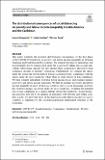Files in this item
The distributional consequences of social distancing on poverty and labour income inequality in Latin America and the Caribbean
Item metadata
| dc.contributor.author | Delaporte, Isaure | |
| dc.contributor.author | Escobar, Julia | |
| dc.contributor.author | Pena, Werner | |
| dc.date.accessioned | 2021-07-28T10:30:03Z | |
| dc.date.available | 2021-07-28T10:30:03Z | |
| dc.date.issued | 2021-07-28 | |
| dc.identifier | 274878790 | |
| dc.identifier | 247084a5-497a-448a-a776-db41f13bae21 | |
| dc.identifier | 85111504101 | |
| dc.identifier | 000678455500001 | |
| dc.identifier.citation | Delaporte , I , Escobar , J & Pena , W 2021 , ' The distributional consequences of social distancing on poverty and labour income inequality in Latin America and the Caribbean ' , Journal of Population Economics , vol. First Online . https://doi.org/10.1007/s00148-021-00854-1 | en |
| dc.identifier.issn | 0933-1433 | |
| dc.identifier.other | ORCID: /0000-0003-0279-2032/work/97885714 | |
| dc.identifier.uri | https://hdl.handle.net/10023/23660 | |
| dc.description.abstract | This paper estimates the potential distributional consequences of the first phase of the COVID-19 lockdowns on poverty and labour income inequality in 20 Latin American and Caribbean (LAC) countries. We estimate the share of individuals that are potentially able to remain active under the lockdown by taking into account individuals’ teleworking capacity but also whether their occupation is affected by legal workplace closures or mobility restrictions. Furthermore, we compare the shares under the formal (de jure) lockdown policies assuming perfect compliance with the shares under de facto lockdowns where there is some degree of non-compliance. We then estimate individuals’ potential labour income losses and examine changes in poverty and labour income inequality. We find an increase in poverty and labour income inequality in most of the LAC countries due to social distancing; however, the observed changes are lower under de facto lockdowns, revealing the potential role of non-compliance as a coping strategy during the lockdowns. Social distancing measures have led to an increase in inequality both between and within countries. Lastly, we show that most of the dispersion in the labour income loss across countries is explained by the sectoral/occupational employment structure of the economies. | |
| dc.format.extent | 59 | |
| dc.format.extent | 2740799 | |
| dc.language.iso | eng | |
| dc.relation.ispartof | Journal of Population Economics | en |
| dc.subject | COVID-19 | en |
| dc.subject | Social distancing | en |
| dc.subject | Compliance | en |
| dc.subject | Employment | en |
| dc.subject | Poverty | en |
| dc.subject | Labour income inequality | en |
| dc.subject | HN Social history and conditions. Social problems. Social reform | en |
| dc.subject | RA0421 Public health. Hygiene. Preventive Medicine | en |
| dc.subject | E-DAS | en |
| dc.subject | SDG 3 - Good Health and Well-being | en |
| dc.subject | SDG 10 - Reduced Inequalities | en |
| dc.subject.lcc | HN | en |
| dc.subject.lcc | RA0421 | en |
| dc.title | The distributional consequences of social distancing on poverty and labour income inequality in Latin America and the Caribbean | en |
| dc.type | Journal article | en |
| dc.contributor.institution | University of St Andrews. School of Geography & Sustainable Development | en |
| dc.identifier.doi | 10.1007/s00148-021-00854-1 | |
| dc.description.status | Peer reviewed | en |
This item appears in the following Collection(s)
Items in the St Andrews Research Repository are protected by copyright, with all rights reserved, unless otherwise indicated.

